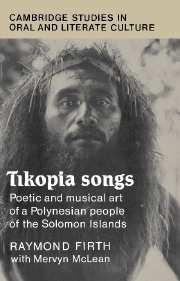Book contents
- Frontmatter
- Contents
- ILLUSTRATIONS
- FIGURES
- Preface
- Acknowledgements
- Sketch map of Tikopia (approx. 5 sq. km.)
- Part I General
- Part II Musical analysis (by Mervyn McLean)
- 5 The structure of Tikopia music
- Part III Song texts, translations and commentary
- Appendix 1 Composers to whom songs attributed
- References
- Index
5 - The structure of Tikopia music
Published online by Cambridge University Press: 07 May 2010
- Frontmatter
- Contents
- ILLUSTRATIONS
- FIGURES
- Preface
- Acknowledgements
- Sketch map of Tikopia (approx. 5 sq. km.)
- Part I General
- Part II Musical analysis (by Mervyn McLean)
- 5 The structure of Tikopia music
- Part III Song texts, translations and commentary
- Appendix 1 Composers to whom songs attributed
- References
- Index
Summary
Introduction
The analysis undertaken here is of recordings which may loosely be described as the Firth collection: i.e. recordings from disparate sources in the possession of Raymond Firth and made available by him for analysis. In accordance with Firth's own choice of songs elsewhere in the book no account is taken of modern songs (mostly with guitar or ukulele accompaniment). These are discussed by Firth in Chapter 1.
The starting point for analysis was to transcribe into music notation all transcribable items on tape. Over 60 songs were transcribed in full and some in part. Because of space limitations few of these transcriptions can be published here. In the interests of the general reader the analysis is likewise severely curtailed.
Manner of singing
Distinctive vocal quality in a singing style is easy to recognise but notoriously difficult to describe. Firth's description of Tikopia singing (p. 30) as tending towards harshness may be accepted but is applicable mainly to group rather than solo singing. Soloists such as Ishmael Tuki who recorded at Auckland in 1978 and the Ariki Taumako, who recorded for Firth in 1966, sang in a relatively relaxed manner though with some rasp in the latter case. Group singing has moderate nasality and tension, especially in dance-songs. As the latter approach their climax, shouts and cries are interspersed, the song gets faster and louder, and a shouted quality of voice becomes more prevalent in the singing itself, adding to the impression of harshness.
- Type
- Chapter
- Information
- Tikopia SongsPoetic and Musical Art of a Polynesian People of the Solomon Islands, pp. 107 - 124Publisher: Cambridge University PressPrint publication year: 1991



